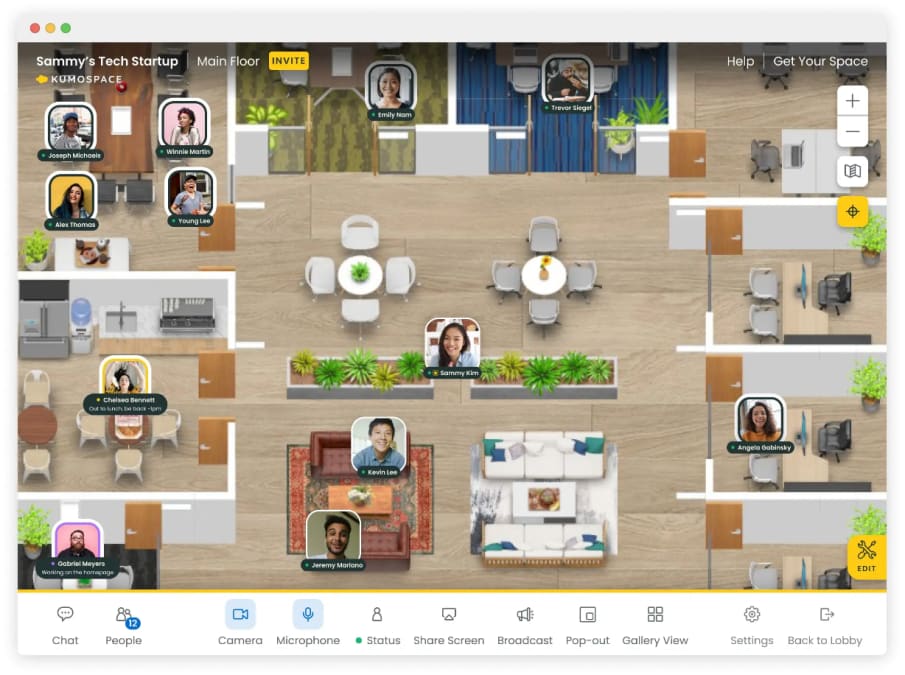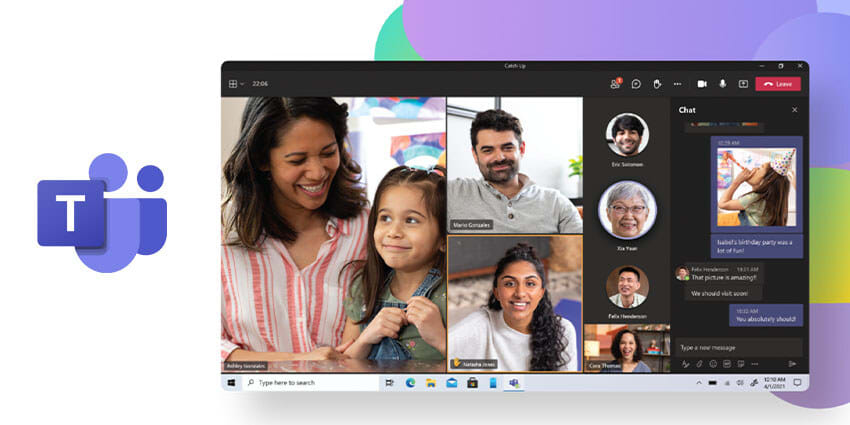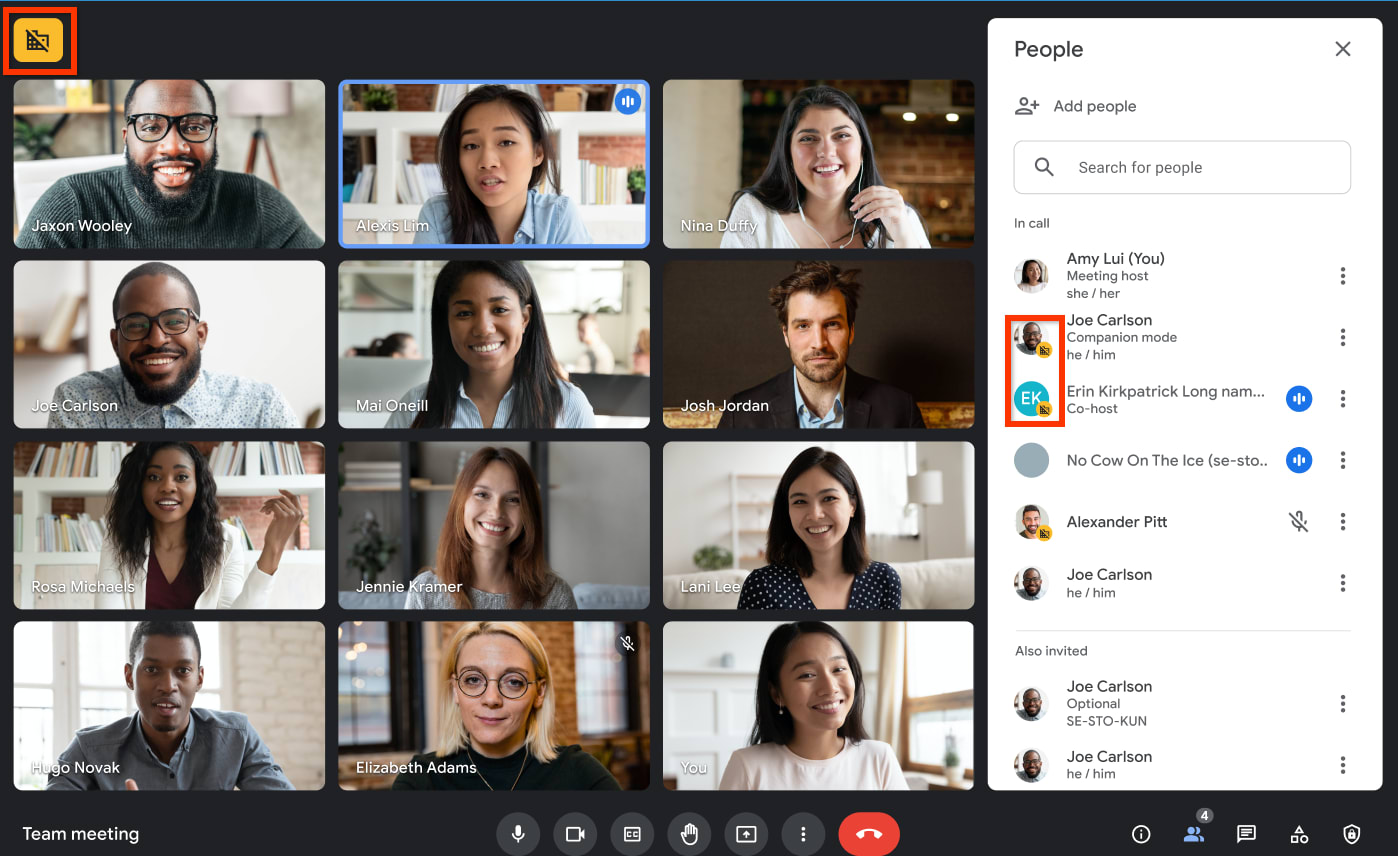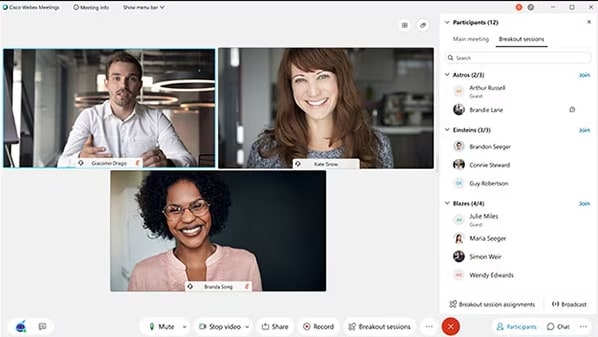In today’s fast-paced, globally connected world, video conferencing has become essential for businesses and individuals. As remote work and virtual collaboration continue to grow in popularity, it’s more important than ever to choose the right video conferencing solution to meet your needs and budget. But with a vast array of options available, how can you ensure that you’re making the right choice? In this video conferencing buying guide, we’ll explore the different types of video conferencing solutions, essential equipment, and factors to consider when choosing a platform. We’ll also compare popular services like Kumospace, Zoom, Microsoft Teams, Google Meet, and Webex to help you find the best fit for your organization.
Key takeaways
- Understand video conferencing solutions and essential equipment to make an informed decision.
- Invest in high-quality cameras, audio equipment, and displays for a successful experience.
- Consider scalability, integration with existing tools, and security measures when selecting a platform. Follow room setup tips & etiquette best practices for optimal experience.
Understanding video conferencing solutions

Video conferencing solutions vary in terms of deployment, features, and costs. Understanding the differences between cloud-based, on-premise, and hybrid solutions can help you make a knowledgeable choice. While cloud-based solutions offer flexibility and easy access, on-premise solutions provide greater control and security.
On the other hand, hybrid video conferencing combines both benefits to offer a balance between flexibility and control. Assisting you in navigating the video conferencing landscape, we shall examine each type of solution more closely.
For remote or hybrid offices, business leaders and team managers must ensure clear and focused communications. Encouraging customization allows workers to express their creativity, building stronger team links.
Cloud-based video conferencing
Cloud-based video conferencing offers flexibility, easy access, and lower upfront costs. Hosted and accessed through the cloud, cloud-based solutions provide a simple setup process, with no software downloads required, and can be accessed instantly through web browsers. This allows users to conveniently communicate with colleagues and clients from any location. However, the primary potential drawbacks of utilizing a soft codec solution include being obligated to an ongoing subscription, lack of control over the system, and inability to run a private system on an internal network.
The functionality of cloud-based video conferencing lets users conduct virtual meetings, presentations, and collaborations without the need for physical infrastructure or dedicated hardware. Accessing the platform is simple, as users can do so through their web browsers without the need for software downloads or complex setups. This provides anytime, anywhere accessibility, making it ideal for remote work, distance learning, and online collaborations. It also cuts travel costs, conserves time, and increases productivity and engagement. The video conferencing capabilities of such a solution should be considered when choosing a video conferencing solution, as the recurring subscription fees for cloud-based video conferencing might differ based on the provider.
On-premise video conferencing
On-premise video conferencing offers several advantages, including:
- Infrastructure ownership
- Enhanced security
- Greater control and customization
- Reliable performance
- Potential cost savings in the long run
However, it may necessitate a greater initial investment and maintenance efforts.
However, the drawbacks of on-premise video conferencing include initial investment, scalability, security, maintenance costs, and lack of flexibility. On-premise video conferencing systems offer high control, flexibility, scalability, and security. These systems are managed internally, providing the necessary support and expertise. Furthermore, they provide powerful hardware components such as HD cameras, audio systems, and peripherals. Moreover, sensitive information is stored within the company’s network, giving IT more control over security.
When contemplating an on-premise solution, it’s beneficial to compare the potential advantages against the drawbacks and costs of this kind of system.
Hybrid video conferencing
Hybrid video conferencing combines the features of both cloud-based and on-premise solutions, allowing organizations to leverage the benefits of both. This integration facilitates seamless communication and collaboration between on-premise and cloud users, optimizing resources and providing a scalable and flexible conferencing solution while also allowing organizations to retain their existing on-premise deployment and increase their ROI.
Essential video conferencing equipment

Investing in vital equipment for video conferencing is key to securing a high-quality experience. Here are some critical considerations for each type of equipment:
- Cameras and webcams: Look for high resolution and wide field of view for clear video quality.
- Audio equipment: Invest in microphones, speakers, and headsets that provide clear sound and noise reduction for effective communication.
- Displays and monitors: Ensure they are appropriately sized and positioned for optimal visibility and collaboration during video conferences.
We shall examine each of these vital components more closely.
Cameras and webcams
Cameras and webcams are essential for providing clear video quality during video conferences. When selecting cameras and webcams, one should consider:
- Resolution: High-resolution cameras and webcams ensure that participants can clearly see each other.
- Field of view: A wide field of view allows for capturing more participants in the frame.
- Platform compatibility: Ensures that the chosen camera or webcam will work seamlessly with your chosen video conferencing platform.
Beyond considering these factors, selecting a camera or webcam that fits your specific video conferencing requirements is also necessary. For instance, a built-in camera in a laptop might be sufficient for one-on-one video calls, but for larger group meetings or conferences, a dedicated video conferencing camera with a wider field of view and higher resolution may be necessary. Investment in suitable video conferencing cameras is key for ensuring clear and effective communication during video conferences.
Audio equipment
Clear audio is key to effective communication during video conferences, making audio and video devices like:
- Microphones: should pick up the speaker’s voice clearly and effectively
- Speakers: should provide clear audio playback for all participants
- Headsets: can be especially useful for individuals in noisy environments, as they can help eliminate background noise and ensure clear audio input and output
When choosing audio equipment, it’s essential to consider the specific needs of your video conferencing setup. A simple yet reliable microphone and speaker setup may be sufficient for a small meeting room or home office. However, investing in more advanced audio equipment, such as beamforming microphone arrays or noise reduction technologies, might be necessary for larger conference rooms or more complex setups to ensure optimal audio quality during video conferences.
Displays and monitors
Displays and monitors play a key role in video conferencing, enabling participants to view each other and any shared content distinctly. When choosing a display or monitor for video conferencing, it’s important to consider factors such as size, position, and any additional features that can facilitate collaboration, such as touch displays or digital whiteboards.
Ensuring the chosen display or monitor is appropriately sized and positioned for optimal visibility and collaboration during video conferences can boost the overall video conferencing experience.
Factors to consider when choosing a video conferencing platform

Factors like scalability, integration with existing tools, and security measures to shield sensitive information should be considered when selecting a video conferencing platform. By taking these factors into account, you can ensure that your chosen platform can grow with your business and adapt to changing needs while also maintaining compliance with industry standards and regulations.
We shall further examine each of these factors.
Scalability and flexibility
Scalability and flexibility are essential when choosing a video conferencing platform, as they ensure that the platform can grow with your business and adapt to changing needs. Scalable video conferencing solutions can easily incorporate new users and bridge multiple platforms or devices, providing an uninterrupted experience without compromising the video and audio quality. Flexibility, on the other hand, allows users to connect to meetings from a range of devices, providing convenience and access.
When assessing a video conferencing platform’s scalability and flexibility, the following aspects should be considered:
- Simplicity
- Reliability
- Security
- Collaboration features
- Integration capabilities
- Compatibility
- Customization options
- Support and training
- Cost-effectiveness
By choosing a platform that offers both scalability and flexibility, you can ensure that your video conferencing solution will be able to adapt and grow with your organization’s needs.
Integration and compatibility
Integration and compatibility with other software and devices are key factors when choosing a video conferencing platform. Integrating with other software solutions can facilitate organizational communication and collaboration, allowing for more efficient workflows and seamless information sharing. Compatibility with a range of devices ensures that all participants can easily connect to video conferences, regardless of their device.
Several video conferencing platforms integrate with popular productivity tools like Slack making it even more convenient for users to collaborate and share information during video conferences. When selecting a video conferencing platform, it’s essential to consider its integration and compatibility capabilities to ensure a smooth, seamless experience for all participants.
Security and privacy
Security and privacy are key factors to consider when choosing a video conferencing platform, as they aid in protecting sensitive information and maintaining compliance with industry standards and regulations. Video conferencing platforms should offer security features such as encryption, authentication, and access control to ensure the privacy and security of your data.
By choosing a video conferencing platform with robust security and privacy features, you can ensure that your organization’s sensitive information is protected and that you remain compliant with industry standards and regulations.
Popular video conferencing services comparison

Comparing popular video conferencing services such as Kumospace, Zoom, Microsoft Teams, Google Meet, and Webex can help you determine the best fit for your organization’s needs and budget. Each platform offers unique features and capabilities that cater to different requirements, so it's essential to carefully consider the pros and cons of each service before making a decision.
We examine these popular video conferencing services, and their offerings more closely.
Kumospace

Kumospace offers a unique, immersive video conferencing experience with customizable virtual spaces. Its distinctive features include:
- Presenting: Allows users to share their screen and present content to others in the virtual space.
- Pop-Outs: Enables users to have private conversations with specific individuals while still in the virtual space.
- Gallery View: Displays all participants in a grid format, making it easy to see everyone simultaneously.
- Spatial Audio: Enhances virtual interactions by providing a more natural feel, as voices sound like they are coming from different directions.
In addition to these features, Kumospace provides a richly illustrated virtual work environment and unique remote team-building features, setting it apart from other video conferencing platforms.
Kumospace offers various pricing plans to accommodate different needs and budgets. Here are the available plans:
- Free plan: Allows up to 10 registered users.
- Business plan: $16/month per user.
- Enterprise plan: Custom pricing for larger organizations.
- Packages for larger events start at $1,000.
Kumospace’s immersive video conferencing experience and flexible pricing make it an interesting option for your organization.
Zoom

Zoom is a widely used platform known for its ease of use, extensive features, and integration capabilities. Users can easily join and host video conferences, schedule meetings, and share their screens for presentations. Zoom offers features such as breakout rooms, improved whiteboards, live transcription, and spotlighting people, among others, making it a versatile solution for businesses of all sizes.
One of Zoom's main advantages is its seamless integration with other tools and services, making it ideal for organizations that rely on various productivity and communication tools. With its simple user interface and robust feature set, Zoom has become a popular choice for video conferencing across various industries.
Microsoft Teams

Microsoft Teams provides a comprehensive collaboration solution, integrating video conferencing with other Microsoft 365 tools. This integration allows users to easily access their files, collaborate on documents, and schedule meetings all within a single platform. Microsoft Teams also offers unique features for video conferencing, such as breakout rooms, improved whiteboard, live transcription, and spotlighting people, making it a powerful tool for businesses that rely on Microsoft 365.
In addition to its robust feature set and seamless integration with other Microsoft tools, Microsoft Teams also provides a secure and compliant video conferencing solution. With features such as:
- Encryption
- Information protection
- Data and privacy safeguards
- End-to-end encryption for calls
Microsoft Teams protects your organization’s sensitive information during video conferences.
Google Meet

Google Meet offers seamless integration with Google Workspace, allowing users to easily schedule and join video conferences directly from their Google Calendar and Gmail. As a browser-based solution, Google Meet provides a user-friendly experience that requires no software downloads, making it easy for participants to join meetings with just a few clicks.
Google Meet also offers various features to enhance the video conferencing experience, such as live captions, breakout rooms, and a hand-raising feature for participants. Its integration with other Google Workspace tools, such as Google Drive and Google Slides, makes it an ideal choice for organizations that rely heavily on Google’s suite of productivity tools.
Webex

Webex, backed by Cisco, is a mature and reliable video conferencing solution suitable for businesses of all sizes. With a comprehensive suite of features, including HD video, screen sharing, and advanced meeting controls, Webex provides a powerful platform for hosting virtual meetings and events. Webex also offers strong security features, such as end-to-end encryption and password-protected meetings, ensuring your organization’s sensitive information is protected.
In addition to its robust feature set and strong security measures, Webex offers integration with various productivity tools and services, including:
- Microsoft Office 365
- Google Workspace
- Salesforce
- Slack
- Dropbox
These integrations make it easy for users to collaborate and share information during video conferences. With its reliable performance and extensive capabilities, Webex is a popular choice for organizations looking for a comprehensive video conferencing solution.
Tips for optimizing your video conferencing experience

Optimizing your video conferencing experience includes proper room setup, ample connectivity, and adherence to etiquette and best practices. Considering these factors, you can ensure a smooth and productive video conferencing experience for all participants.
We shall further examine some tips for improving video conferences and video meetings using a conferencing system and its accompanying software.
Room setup and acoustics
Room setup and acoustics ensure clear communication and minimize distractions during video conferences. A well-configured space should include an appropriate layout, interactive features, and sound-absorbing decorations, such as rugs, wall art, fabric blinds or curtains, soft furniture, and plants, to help reduce noise and improve audio quality.
Additionally, the placement of speakers and microphones should be carefully considered to ensure clear audio transmission during video conferences. For instance, placing microphones and speakers on the tables where participants are seated, or installing a sound bar under the video display screen, can help optimize audio quality and reduce echo or reverberation.
Connectivity and bandwidth
Connectivity and bandwidth requirements should be considered to prevent lag and dropped calls, thus ensuring a smooth video conferencing experience. Insufficient bandwidth can lead to pixelated or blurry video, choppy audio, and communication lags, while greater bandwidth allows for higher-resolution video and an improved overall experience.
To determine the necessary bandwidth for a video call, consider the resolution, frame rate, and video codec in use. Multiplying these requirements can provide an estimate of the bandwidth required. For example, a 720p video call at 30fps using the H.264 codec may require approximately 1-2 Mbps download bandwidth and 0.75-1.4 Mbps upload bandwidth.
Ensuring that your network can support the necessary bandwidth for video conferencing will help guarantee a smooth and enjoyable experience for all participants.
Etiquette and best practices
Etiquette and best practices for video conferencing include:
- Muting when not speaking
- Maintaining eye contact
- Minimizing distractions
- Ensuring clear communication
By following these simple guidelines, participants can contribute to a professional and productive video conferencing environment.
Additionally, being mindful of meeting etiquette can help create a more engaging and effective video conferencing experience for all participants.
Summary
In conclusion, choosing the right video conferencing solution involves carefully considering factors such as deployment type, equipment, scalability, integration, and security. By comparing popular services like Kumospace, Zoom, Microsoft Teams, Google Meet, and Webex, and following tips for optimizing your video conferencing experience, you can ensure that your organization’s communication needs are met effectively and efficiently. With the right video conferencing platform and equipment, your organization can enjoy seamless virtual collaboration and thrive in today’s increasingly connected world.
Frequently asked questions
Size and the number of participants are key factors in selecting a video conferencing system. The system must provide adequate coverage so that all participants can be seen and heard without compromising meeting quality.
To use video conferencing, one needs reliable high-speed internet, a webcam, microphone, speakers, and compatible video conferencing software.
Cloud-based video conferencing is hosted and accessed through the cloud for greater flexibility and easy access, whereas on-premise solutions are hosted within an organization's network for greater control and security.
For a high-quality video conferencing experience, essential equipment includes cameras, audio equipment such as microphones, speakers and headsets, and displays or monitors.
Ensure the scalability and flexibility of your chosen video conferencing platform by evaluating features such as simplicity, reliability, security, collaboration options, integration capabilities, compatibility, customization options, support and training, and cost-effectiveness.





